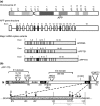Insights into the physiological function of the β-amyloid precursor protein: beyond Alzheimer's disease
- PMID: 24517464
- PMCID: PMC4314671
- DOI: 10.1111/jnc.12675
Insights into the physiological function of the β-amyloid precursor protein: beyond Alzheimer's disease
Abstract
The β-amyloid precursor protein (APP) has been extensively studied for its role as the precursor of the β-amyloid protein (Aβ) of Alzheimer's disease. However, the normal function of APP remains largely unknown. This article reviews studies on the structure, expression and post-translational processing of APP, as well as studies on the effects of APP in vitro and in vivo. We conclude that the published data provide strong evidence that APP has a trophic function. APP is likely to be involved in neural stem cell development, neuronal survival, neurite outgrowth and neurorepair. However, the mechanisms by which APP exerts its actions remain to be elucidated. The available evidence suggests that APP interacts both intracellularly and extracellularly to regulate various signal transduction mechanisms. This article reviews studies on the structure, expression and post-translational processing of β-amyloid precursor protein (APP), as well as studies on the effects of APP in vitro and in vivo. We conclude that the published data provide strong evidence that APP has a trophic function. APP is likely to be involved in neural stem cell development, neuronal survival, neurite outgrowth and neurorepair. However, the mechanisms by which APP exerts its actions remain to be elucidated. The available evidence suggests that APP interacts both intracellularly and extracellularly to regulate various signal transduction mechanisms.
Keywords: Alzheimer's disease; amyloid precursor protein; growth factor; heparin; neurotrophic; receptor.
© 2014 The Authors. Journal of Neurochemistry published by John Wiley & Sons Ltd on behalf of The International Society for Neurochemistry.
Figures


References
-
- Abramov E, Dolev I, Fogel H, Ciccotosto GD, Ruff E, Slutsky I. Amyloid-beta as a positive endogenous regulator of release probability at hippocampal synapses. Nat. Neurosci. 2009;12:1567–1576. - PubMed
-
- Akar CA, Wallace WC. Amyloid precursor protein modulates the interaction of nerve growth factor with p75 receptor and potentiates its activation of trkA phosphorylation. Brain Res. Mol. Brain Res. 1998;56:125–132. - PubMed
-
- Annich G, White T, Damm D, Zhao Y, Mahdi F, Meinhardt J, Rebello S, Lucchesi B, Bartlett RH, Schmaier AH. Recombinant Kunitz protease inhibitory domain of the amyloid beta-protein precursor as an anticoagulant in venovenous extracorporeal circulation in rabbits. Thromb. Haemost. 1999;82:1474–1481. - PubMed
Publication types
MeSH terms
Substances
LinkOut - more resources
Full Text Sources
Other Literature Sources
Medical

